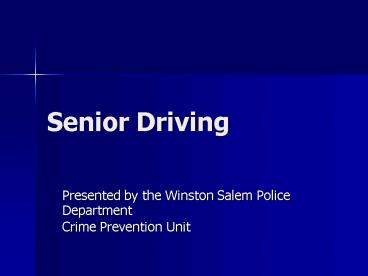Senior Driving PowerPoint PPT Presentation
1 / 16
Title: Senior Driving
1
Senior Driving
- Presented by the Winston Salem Police Department
- Crime Prevention Unit
2
We Need To Talk
- Conversations about safe driving should occur
long before driving becomes a problem - Successful family conversations begin with good
preparation and caring conversation - Limited driving presents practical problems and
strong emotions
3
National statistics showed fatalities rose
by 7 for drivers 75 or older from 1981
to 2000.
4
Safe Driving Habits of Senior Drivers
- Least likely to use unsafe driving practice
- Least likely to drive fast or aggressively
- High safety belt use
- Few citations for speeding, reckless driving or
alcohol related offenses
5
Number of crashes for senior drives
decrease as age increases because
- Seniors drive fewer miles
- Seniors avoid driving at night
- Seniors avoid driving during bad weather
- Seniors avoid driving during rush hour traffic
6
However, senior drivers are more likely to
be injured or die when they are involved
in vehicle crashes.
7
Risk Factors
- Medication use
- Reduced physical functions
- Frailty or weakness in joints or muscles
- Pre-existing medical conditions
- Dementia
- Impaired hearing
8
Risk Factors cont
- Vision
- Cataracts
- Glaucoma
- Diabetes
- Failing peripheral vision
- Sensitive to glare
9
Drivers 65 or older who are killed in
vehicle crashes were significantly more
likely to die from chest injury. Older
drivers were more likely to die at a later
date, after the vehicle crash.
10
Warning Signs of Unsafe Driving
- Feeling more nervous or fearful while driving
- Feeling exhausted after driving
- Difficulty staying in your lane of travel
- Close calls (near crashes)
- Trouble moving foot from gas to brake pedal or
confusing the two - Trouble paying attention to signals, road signs,
and pavement markings
11
Stop/Limit Driving When
- Your getting lost frequently
- You have medical conditions or are taking
medications that may be affecting your ability to
handle the car safely - Your easily distracted while driving
- You have difficulty staying in your travel lane
- Your nervous or fearful while driving
- Dents/scrapes on car, mailbox, garage doors
12
Smart Driving Tips
- Before you leave plan
- To drive on streets you are familiar with
- Travel to places you know and are close to home
- Limit routes with risky spots like ramps and left
turns - Allow extra time for travel
13
Smart Driving Tips cont
- While driving
- Always wear your seatbelt
- Avoid using the cell phone (pull over)
- Keep headlights on
- Following distance should be at least two car
lengths between you and the car in front
14
Smart Driving Tips cont
- Car Safety
- Drive a car with features that make driving
easier, such as power steering and brakes, large
mirrors, automatic transmission - Check and replace windshield wiper blades often.
- Clean headlights
15
- What you Need is
- Visual Acuity Vital for driving in low
visibility conditions such as dusk, rain or fog - High Contrast Visual Acuity Needed to identify
pavement markings, as well as detect many types
of hazards in or near the road - Working Memory Important in following
directions, remembering traffic rules and
regulations, and using information on highway
guide signs - Head/Neck Flexibility - Essential in checking
blind spots, lane changes or merging
16
- Questions???

